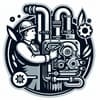Podcast
Questions and Answers
Which leadership theory posits that effective leaders are defined by innate qualities and destined for leadership roles?
Which leadership theory posits that effective leaders are defined by innate qualities and destined for leadership roles?
- Great Man Theories (correct)
- Situational Theories
- Trait Theories
- Behavioral Theories
A manager uses a system of rewards and punishments to guide employee performance. Which leadership theory aligns with this approach?
A manager uses a system of rewards and punishments to guide employee performance. Which leadership theory aligns with this approach?
- Participative Theories
- Contingency Theories
- Relationship Theories
- Management Theories (correct)
What is the primary focus of relationship theories of leadership?
What is the primary focus of relationship theories of leadership?
- Establishing connections between leaders and followers. (correct)
- Implementing systems of rewards and punishments.
- Emphasizing inherent leadership traits.
- Adapting leadership styles to different situations.
Which type of manager is most likely to represent the organization in ceremonial activities?
Which type of manager is most likely to represent the organization in ceremonial activities?
Which management role involves actively scanning the environment for relevant data?
Which management role involves actively scanning the environment for relevant data?
What is a key characteristic of autocratic management style?
What is a key characteristic of autocratic management style?
Which management style is most likely to foster creativity, independence, and self-motivation among employees?
Which management style is most likely to foster creativity, independence, and self-motivation among employees?
A manager focuses on setting clear expectations and providing direct instructions. Which management style is being used?
A manager focuses on setting clear expectations and providing direct instructions. Which management style is being used?
Which leadership quality involves understanding and relating to the emotions and perspectives of others?
Which leadership quality involves understanding and relating to the emotions and perspectives of others?
What is the foundational step in the management process?
What is the foundational step in the management process?
In which management function do managers monitor performance and take corrective actions?
In which management function do managers monitor performance and take corrective actions?
Which role do managers play when they represent the organization in negotiations with other parties?
Which role do managers play when they represent the organization in negotiations with other parties?
What is the primary focus of the 'organizing' function in management?
What is the primary focus of the 'organizing' function in management?
Within an organization, what is the role of a 'liaison'?
Within an organization, what is the role of a 'liaison'?
What does effective decision-making involve?
What does effective decision-making involve?
Which technique involves individuals making decisions based on their own judgment and expertise?
Which technique involves individuals making decisions based on their own judgment and expertise?
What is one potential drawback of group decision-making?
What is one potential drawback of group decision-making?
Which type of decisions are aligned with the national development plan and government plan?
Which type of decisions are aligned with the national development plan and government plan?
What is the purpose of tactical decisions?
What is the purpose of tactical decisions?
What does data-driven decision-making involve?
What does data-driven decision-making involve?
What is the initial step in quick and fast decision-making?
What is the initial step in quick and fast decision-making?
What type of tool can managers use to identify strengths, weaknesses, opportunities, and threats?
What type of tool can managers use to identify strengths, weaknesses, opportunities, and threats?
A manager decides to empower team members to make decisions within their areas of expertise. Which guide for quick decision making is this manager applying?
A manager decides to empower team members to make decisions within their areas of expertise. Which guide for quick decision making is this manager applying?
What is the primary focus of 'participative leadership theories'?
What is the primary focus of 'participative leadership theories'?
Which of the following is a potential disadvantage of democratic management?
Which of the following is a potential disadvantage of democratic management?
A manager inspires and motivates employees to achieve a shared vision, especially during times of change. Which management style is being employed?
A manager inspires and motivates employees to achieve a shared vision, especially during times of change. Which management style is being employed?
Which leadership quality emphasizes the ability to bounce back from setbacks and learn from mistakes?
Which leadership quality emphasizes the ability to bounce back from setbacks and learn from mistakes?
Which management role involves identifying opportunities for innovation and change within the organization?
Which management role involves identifying opportunities for innovation and change within the organization?
What is the first step in effective decision-making?
What is the first step in effective decision-making?
What is a potential drawback of individual decision making?
What is a potential drawback of individual decision making?
Which type of decision, out of the options given, is considered a day-to-day decision?
Which type of decision, out of the options given, is considered a day-to-day decision?
What is the first thing one should do in the guides for quick and fast decision making?
What is the first thing one should do in the guides for quick and fast decision making?
A person recognizes that if they make a decision and it does not work out, they can learn from the mistake made. What is this an example of?
A person recognizes that if they make a decision and it does not work out, they can learn from the mistake made. What is this an example of?
Which theory emphasizes that leadership style should vary depending on the situation?
Which theory emphasizes that leadership style should vary depending on the situation?
What distinguishes 'problem-solving' from 'decision-making'?
What distinguishes 'problem-solving' from 'decision-making'?
Why is 'Integrity and Honesty' crucial for leaders and managers?
Why is 'Integrity and Honesty' crucial for leaders and managers?
In which scenario is an autocratic management style most effective?
In which scenario is an autocratic management style most effective?
When making a quick decision, what does the “5-second rule” suggest?
When making a quick decision, what does the “5-second rule” suggest?
Flashcards
Leadership
Leadership
Guiding and motivating people to work together toward a shared goal, developed over time.
"Great Man" Theories
"Great Man" Theories
Theories assuming great leaders are born with inherent leadership capacity.
Trait Theories
Trait Theories
Theories that people inherit qualities and traits that make them suited for leadership.
Contingency Theories
Contingency Theories
Signup and view all the flashcards
Situational Theories
Situational Theories
Signup and view all the flashcards
Behavioral Theories
Behavioral Theories
Signup and view all the flashcards
Participative Theories
Participative Theories
Signup and view all the flashcards
Management Theories
Management Theories
Signup and view all the flashcards
Relationship Theories
Relationship Theories
Signup and view all the flashcards
Management
Management
Signup and view all the flashcards
Top-Level Managers
Top-Level Managers
Signup and view all the flashcards
Middle Managers
Middle Managers
Signup and view all the flashcards
First-Line Managers
First-Line Managers
Signup and view all the flashcards
Autocratic
Autocratic
Signup and view all the flashcards
Democratic
Democratic
Signup and view all the flashcards
Laissez-Faire
Laissez-Faire
Signup and view all the flashcards
Transformational
Transformational
Signup and view all the flashcards
Visionary
Visionary
Signup and view all the flashcards
Coaching
Coaching
Signup and view all the flashcards
Authoritative
Authoritative
Signup and view all the flashcards
Persuasive
Persuasive
Signup and view all the flashcards
Transactional
Transactional
Signup and view all the flashcards
Consultative
Consultative
Signup and view all the flashcards
Vision and Strategic Thinking
Vision and Strategic Thinking
Signup and view all the flashcards
Communication
Communication
Signup and view all the flashcards
Empathy and Emotional Intelligence
Empathy and Emotional Intelligence
Signup and view all the flashcards
Integrity and Honesty
Integrity and Honesty
Signup and view all the flashcards
Motivation and Inspiration
Motivation and Inspiration
Signup and view all the flashcards
Delegation and Empowerment
Delegation and Empowerment
Signup and view all the flashcards
Adaptability and Flexibility
Adaptability and Flexibility
Signup and view all the flashcards
Decision-Making
Decision-Making
Signup and view all the flashcards
Planning
Planning
Signup and view all the flashcards
Organizing
Organizing
Signup and view all the flashcards
Leading
Leading
Signup and view all the flashcards
Controlling
Controlling
Signup and view all the flashcards
Figurehead
Figurehead
Signup and view all the flashcards
Leader
Leader
Signup and view all the flashcards
Liaison
Liaison
Signup and view all the flashcards
Monitor
Monitor
Signup and view all the flashcards
Disseminator
Disseminator
Signup and view all the flashcards
Study Notes
- Leadership is guiding and motivating teamwork toward a shared objective; it's a skill cultivated over time.
Theories of Leadership
- "Great Man" theories state leadership is inherent; great leaders are born, portrayed as heroic or mythic, and predestined for leadership, typically deemed a male quality, historically in military contexts.
- Trait theories posit leadership is inherited via traits, identifying personality/behavioral traits shared by leaders like extroversion, self-confidence, and courage.
- Contingency theories state leadership hinges on environmental variables, implying no style suits all situations.
- Situational theories propose leaders select actions based on variables, suggesting leadership styles align with decision types.
- Behavioral theories claim great leaders are made, not born, contrasting Great Man Approach.
- Participative theories advocate for input-inclusive leadership, encouraging contributions for team relevance and commitment.
- Management theories, or transactional theories, emphasize supervision, organization, and group performance, grounding leadership in rewards and punishments.
- Relationship theories, or transformational theories, emphasize leader-follower connections, requiring high ethics and morals.
- Management includes planning, organizing, leading, and controlling resources to achieve organizational goals efficiently.
Types of Managers
- Top-level managers are executive-level leaders with "chief" in their titles, leading as chief executive officers.
- Middle managers report to top-level managers, having autonomy for departmental decisions, often with "director" titles, acting as liaisons for manager levels, ensuring communication.
- First-line managers hold entry-level roles, communicating concerns to middle management, addressing employee needs as liaisons.
Management Styles
- Autocratic management involves independent decision-making with less input, focusing on control and efficiency, enabling clear direction in crises, but risks stifling creativity.
- Democratic management promotes participation, collaboration, increased engagement, higher morale, and improved problem-solving, but time-consuming decisions.
- Laissez-Faire management is a hands-off, autonomy-allowing approach that promotes creativity and self-motivation, but risks less direction or accountability.
- Transformational management inspires shared vision, driving innovation and strong purpose, yet requires significant leader effort.
- Visionary management focuses on long-term goals, giving purpose and direction, but demanding strong communication and leadership skills.
- Coaching management develops employee skills as mentors, improving performance and culture, but needs time and implementation.
- Authoritative management sets clear expectations with discipline, effective in crises situations, but risks stifling creativity.
- Persuasive management involves teams in decisions, explaining the rationale, which boosts buy-in, but may be time-consuming.
- Transactional management monitors performance, rewarding/punishing results, can maintaining order, but risks being less creative
- Consultative management seeks team input retaining the final say, boosting engagement and morale, but can reduce motivation.
Characteristics of Leaders and Managers
- Vision and Strategic Thinking are required to envision the future and create a clear path.
- Leaders must communicate clearly to ensure everyone understands the vision and goals.
- Empathy and Emotional Intelligence are requirements to understand perspectives to build trust and rapport.
- Integrity and Honesty means acting ethically to earn team respect and trust.
- Motivation and Inspiration is needed to inspire teams to achieve their potential.
- Delegation and Empowerment involves delegating tasks empowering team members' ownership.
- Adaptability and Flexibility allows adapting to embrace new ideas when addressing circumstances.
- Decision-Making includes effective decisions based on insight.
- Self-Awareness is necessary to leverage strengths while understanding and addressing weaknesses.
- Active Listening is required to understand team member concerns.
- Accountability means taking responsibility.
- Resilience includes learning from setbacks.
- Passion and Enthusiasm help to create contagious enthusiasm.
- Confidence is important to build trust.
- Courage means taking risks to make decisions.
Fundamental Functions of Management
- Planning sets objectives, strategies, and action plans, serving as the basis for all actions.
- Organizing structures work, assigns tasks, and establishes communication channels for efficient operation.
- Leading involves motivating and guiding employees, building teams, and inspiring performance.
- Controlling ensures goal tracking, deviation identification, corrective actions, and standards setting.
Roles of Managers within Organizations
- As Figureheads, managers represent their organization during symbolic events.
- Managers act as Leaders by motivating staff, promoting positive environments, and setting expectations.
- As Liaisons, they build internal/external relationships.
- By Monitoring, managers scan for relevant information.
- As Disseminators, they share important information with employees.
- As Spokespersons, they communicate their organization's perspective.
- As Entrepreneurs, they identify opportunities.
- As Disturbance Handlers, they address unexpected problems effectively.
- As Resource Allocators, they allocate time, budget, and personnel.
- As Negotiators, they represent organizations in negotiations.
Basics of Decision Making
- Effective decision-making includes identifying the problem, gathering data, evaluating options, selecting the best action, and assessing outcomes.
- Problem-solving is identifying and resolving issues.
- Decision-making selects a course of action.
Characteristics of Problem Solving and Decision Making
- Problem-solving is a process leading to a decision on a solution's implementation.
- Decision-making is a vital skill for informed choices.
Decision-Making Techniques
- Individual Decision Making involves independently assessing and deciding by judgement.
- Speed, autonomy, limited perspective, and potential bias are aspects of individual decision making.
- Group Decision Making involves collaboration and negotiation.
- Diverse perspectives, increased knowledge, improved quality, time consumption, conflict potential and groupthink are aspects of group decision making.
Decision Making for Public Managers
- Strategic decisions define long-term intent aligned with policies.
- Tactical decisions materialize vision into strategy.
- Operational decisions materialize daily strategy.
Information or Research Decision Making
- Data-driven decision-making uses facts and analysis to guide decisions over intuition.
Guides for Quick and Fast Decision Making
- Clarify the decision, define the problem, set goals, and determine stakes.
- Focus on relevant data, use tools like SWOT, and manage emotions when gathering information efficiently.
- List alternatives, and create a matrix to prioritize choices during options evaluation.
- Develop intuition, take action quickly, and embrace a growth mindset by trusting instincts.
- Commit to the chosen option without reevaluating, delegate when applicable, and continuously learn.
Studying That Suits You
Use AI to generate personalized quizzes and flashcards to suit your learning preferences.





